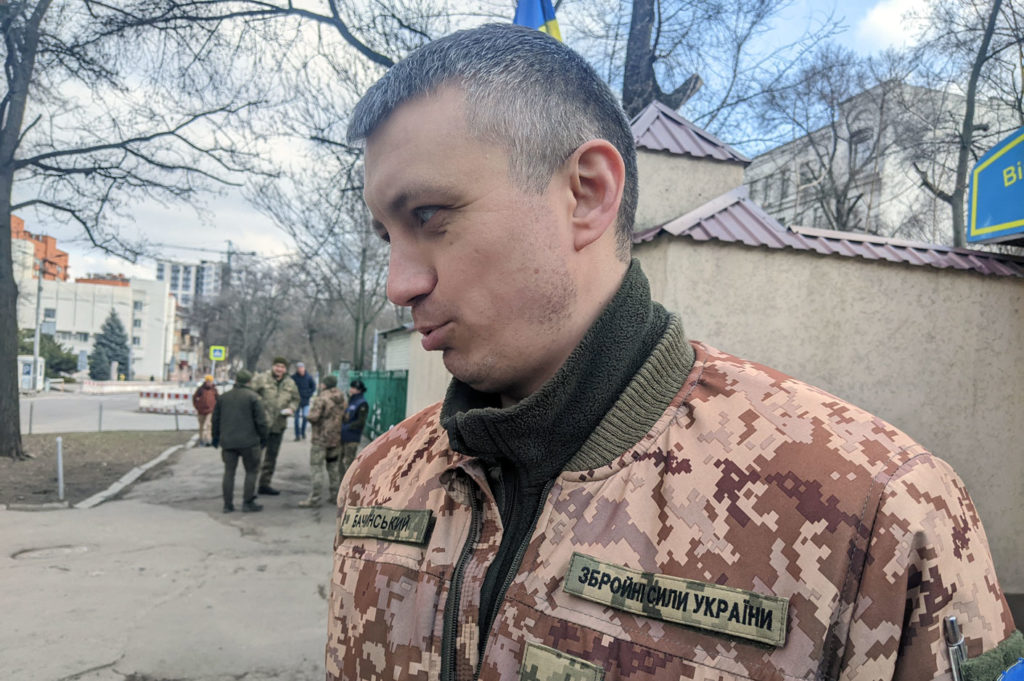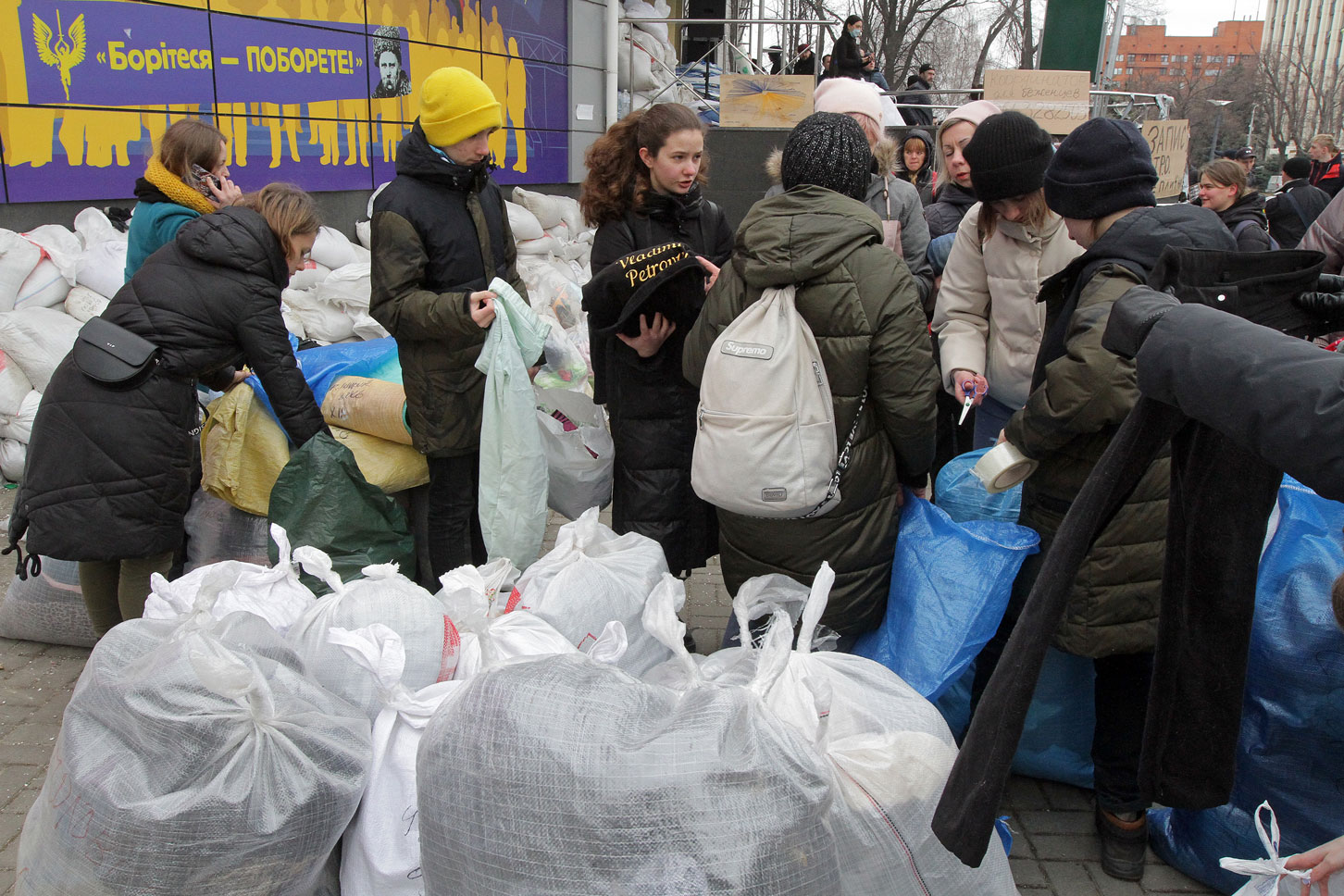The Dnieper is the river that defines Ukraine. Bisecting the country down the middle from north to south, it has served as the lifeblood of the country for centuries, from hosting the capital Kyiv on its upper reaches to providing a crucial link at its mouth on the Black Sea.
Sitting roughly astride the center of the river’s course is the city that bears its name, Dnipro. Amid Russia’s ongoing campaign to conquer Ukraine, it has become a key logistics node for dispatching supplies to battlefields in the country’s north, east and south.
Another of its key tasks is hosting those fleeing war in nearby cities, as the Russian military machine grinds on. At a gas station not far from the mile-and-a-half-wide river, a volunteer unloads his cargo: displaced people from Kharkiv, the northeastern city being pulverized by Russian artillery.
Dan Kislov, a 20-year-old trainee chef, has rented a couple of vans with two of his friends. They spend their days making trips to semi-besieged Kharkiv, bringing supplies in one direction and civilians in the other.
“I brought 18 people here [today],” Kislov says, his easy smile not betraying the difficulty of his work. “We only have seats for 12 people in here, but we manage to fit 19 or 20 most times, with people crammed in the aisles or standing.”
Around 700,000 people, roughly half of Kharkiv’s population, have already fled as the city is subjected to near-nonstop shelling. But many more are still looking to leave.
“There are a lot of people hiding in bomb shelters or metro stations [in Kharkiv] who want to leave,” Kislov says. “They’re afraid to leave because they don’t know what’s going on [above ground]. They don’t want to be left alone in an unsafe situation. So we get calls, pick them up and take them out.”
He and his two friends have evacuated about 1,000 residents of the city so far, he estimates. They have had a few close calls themselves in the process.
“We were lucky enough not to get hit by shelling yet,” Kislov says. “On the second day [of the war], we went to Saltivka district [on the northeast edge of Kharkiv, nearest the Russian positions]. One shell landed not so far away and half-destroyed our car. Thankfully, another car was able to pick us up and get us out.”
In another part of the city, wounded soldiers are receiving treatment. Dnipro’s extensive medical facilities and proximity to the front lines in the country’s east have made it the natural hub for treating the wounded.
Outside the Eastern Region Military Hospital, Serhiy Bachinsky, the 38-year-old deputy head of the facility, describes its crucial role in recent weeks.
“As a medical establishment, we are preparing,” he says. “We’ve expanded the staff, hiring more junior and middle positions. Our establishment has … huge stocks of medical supplies and equipment. As of today, we’ve increased our medical transport capabilities, with more ambulances and even just cars. Basically, we’re ready for any situation, any scenario.”

While Kharkiv was the source of most casualties earlier in the war, the Donbas front, where Russia is pushing hard in an attempt to envelop Ukraine’s many units there, has become the current hot zone.
“Most of our [casualties] arriving here are from the direction of Izyum and Severodonetsk now,” Bachinsky explains, naming two towns in the east that have seen particularly heavy fighting recently. “Kharkiv is more stable now. Russia is moving past it.”
Among the new recruits in Bachinsky’s staff are those from another city in a far more dire situation: Mariupol, the scene of horrific attacks on civilian targets, including a maternity hospital and a theater, and currently surrounded by Russian forces.
“Some of the [Mariupol] staff made it out and are here with us now,” Bachinsky says. “The last contact [with the Mariupol general hospital] was on the 14th. There’s no communication with the rest of them.”
Meanwhile, other preparations are underway. In one of the city’s ad hoc volunteer centers, humanitarian aid is being gathered and distributed, amid increased threats from the air.
Mykola, a 27-year-old member of Dnipro’s Jewish community, points out the extra sandbags covering the windows on the first two floors of the center, the location of which is not disclosed over social media to avoid its being targeted.
“We strengthened the fortifications here after the aid center in Kharkiv was hit,” he says, speaking of an air strike on a similar facility in that city last week. Russia “is targeting these places now,” Mykola adds.
Unlike other aid centers in Ukraine, the Dnipro facility has received a significant amount of international help.
“This is the area where we gather foreign aid,” Mykola says. “We’ve already received a lot from different countries — Poland, Slovakia and others.”
Although the aid is much appreciated, others fear that the world still does not grasp the entirety of Russian President Vladimir Putin’s intentions.
Alex, a 38-year-old volunteer at the center who moved back to Dnipro from Canada last year, underlines this point.
“We are very grateful for [Canada’s] position and support, and from all other countries too,” Alex says. “But if some people have any thoughts about this [Russian war] ending with Ukraine, it won’t. This maniac [Putin] will kill the whole world if he’s not stopped.”
And while Dnipro currently sits far from the front, this is no guarantee it will remain so — a lesson Alex hopes is not lost on those in the rest of the continent.
“Europe thinks it’s very far away,” he says. “But we are two hours [by plane] from Warsaw. Three hours from London. This is Europe.”



